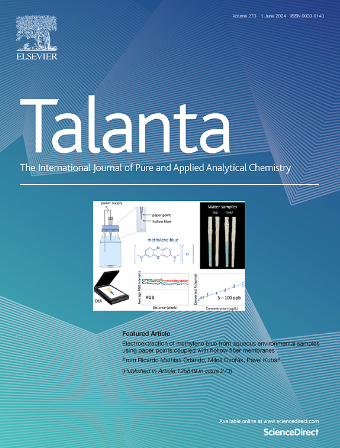加强基于aunp的即时诊断的创新战略:重点关注冠状病毒检测。
IF 6.1
1区 化学
Q1 CHEMISTRY, ANALYTICAL
引用次数: 0
摘要
高致病性冠状病毒一直威胁着人类,包括SARS-CoV、MERS-CoV、SARS-CoV-2等。快速发现和准确诊断对于及时识别高危人群、及时干预、有效切断传播链、减少人员伤亡至关重要。然而,由于设备和训练有素的人员不足,诊断“金标准”逆转录聚合酶链反应(RT-PCR)在大流行期间未能满足压倒性的需求,阻碍了病毒传播的有效控制。毫无疑问,迫切需要开发方便、快速、灵敏的即时诊断技术。金纳米颗粒(AuNPs)由于其优异的光学特性和稳定性,满足了生物传感器的大量市场需求。在这篇全面的综述中,我们总结了AuNPs在视觉溶液比色法和侧流法(LFAs)诊断COVID-19中的潜在优势。我们深入研究了增强LFA信号的技术,目标是提高检测灵敏度和特异性。此外,我们还包括智能手机的应用,以对结果进行公正和客观的解释。本综述中提出的例子有望启发研究人员设计AuNPs生物传感器,以应对当前和未来潜在的传染病暴发。本文章由计算机程序翻译,如有差异,请以英文原文为准。

Innovative strategies for enhancing AuNP-based point-of-care diagnostics: Focus on coronavirus detection
Highly pathogenic coronaviruses have consistently threatened humanity, encompassing SARS-CoV, MERS-CoV, SARS-CoV-2 and others. Swift detection and accurate diagnosis play a crucial role in promptly identifying high-risk populations, enabling timely intervention, and effectively breaking the transmission chain to reduce casualties. However, the diagnostic "gold standard" reverse transcription-polymerase chain reaction (RT-PCR) failed to meet the overwhelming demand during the pandemic due to insufficient equipment and trained personnel, impeding the effective control of viral spread. Undoubtedly, there is an urgent need for the development of convenient, rapid, and sensitive point-of-care (POC) diagnostic technology. Gold nanoparticles (AuNPs) satisfy the substantial market demand for biosensors owing to their exceptional optical properties and stability. In this comprehensive review, we summarize the potential advantages of AuNPs in visual solution colorimetry and lateral flow assays (LFAs) for the diagnosis of COVID-19. We delve into the techniques for enhancing LFA signals, with the goal of increasing both detection sensitivity and specificity. Furthermore, we include the application of smartphones for unbiased and objective interpretation of results. The examples presented in this review are anticipated to inspire researchers in designing AuNPs biosensors to address current and potential outbreaks of infectious diseases in the future.
求助全文
通过发布文献求助,成功后即可免费获取论文全文。
去求助
来源期刊

Talanta
化学-分析化学
CiteScore
12.30
自引率
4.90%
发文量
861
审稿时长
29 days
期刊介绍:
Talanta provides a forum for the publication of original research papers, short communications, and critical reviews in all branches of pure and applied analytical chemistry. Papers are evaluated based on established guidelines, including the fundamental nature of the study, scientific novelty, substantial improvement or advantage over existing technology or methods, and demonstrated analytical applicability. Original research papers on fundamental studies, and on novel sensor and instrumentation developments, are encouraged. Novel or improved applications in areas such as clinical and biological chemistry, environmental analysis, geochemistry, materials science and engineering, and analytical platforms for omics development are welcome.
Analytical performance of methods should be determined, including interference and matrix effects, and methods should be validated by comparison with a standard method, or analysis of a certified reference material. Simple spiking recoveries may not be sufficient. The developed method should especially comprise information on selectivity, sensitivity, detection limits, accuracy, and reliability. However, applying official validation or robustness studies to a routine method or technique does not necessarily constitute novelty. Proper statistical treatment of the data should be provided. Relevant literature should be cited, including related publications by the authors, and authors should discuss how their proposed methodology compares with previously reported methods.
 求助内容:
求助内容: 应助结果提醒方式:
应助结果提醒方式:


